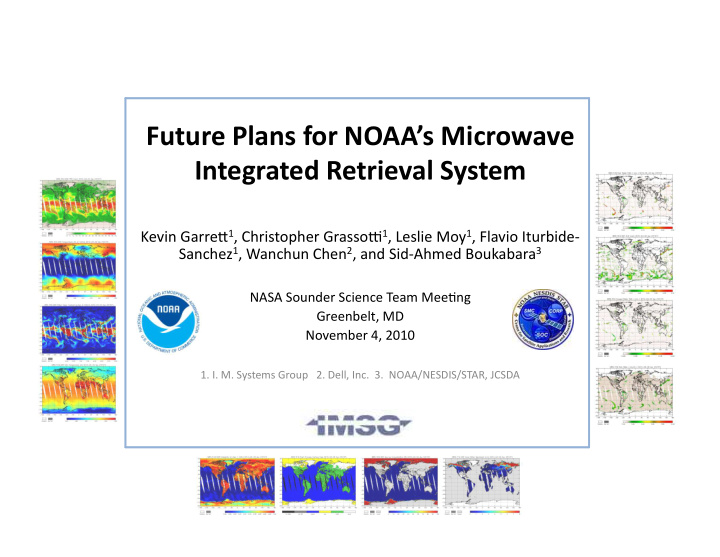



Future Plans for NOAA’s Microwave Integrated Retrieval System Kevin Garre* 1 , Christopher Grasso3 1 , Leslie Moy 1 , Flavio Iturbide‐ Sanchez 1 , Wanchun Chen 2 , and Sid‐Ahmed Boukabara 3 NASA Sounder Science Team MeeJng Greenbelt, MD November 4, 2010 1. I. M. Systems Group 2. Dell, Inc. 3. NOAA/NESDIS/STAR, JCSDA
Agenda • Overview of the Microwave Integrated Retrieval System (MiRS) • The MiRS ValidaJon and Testbed • Ongoing Efforts • MiRS Future Sensors • Summary
Overview • NOAA/NESDIS/STAR has developed a flexible physical algorithm: the Microwave Integrated Retrieval System (MiRS) – Can be applied to any microwave sounder/imager – 1DVAR approach using CRTM as forward and jacobian operators – Retrieves sounding and surface parameters simultaneously, including hydrometeor profiles and surface emissivity – Applicable over all surfaces and in all‐weather condiJons – Run operaJonally at NOAA OSDPD (and integrated at NDE for NPP/JPSS future processing) – MiRS is currently being extended to support GPM
MiRS in Context √ MiRS is applied to a number of microwave sensors, √ each Bme gaining robustness and improving validaBon POES for Future New Sensors N18/N19 Metop‐A • The exact same executable, forward operator, √ covariance matrix used for all sensors DMSP • Modular design SSMIS F16/F18 • CumulaBve validaBon and consolidaBon of MiRS √ AQUA √ √ AMSR‐E √ : Applied OperaBonally TRMM/GPM/ NPP/NPOESS √ : Applied occasionally M‐T ATMS √ : Tested in SimulaBon TMI, GMI proxy, SAPHIR/MADRAS
Algorithm DescripBon VIPP Satellite Tbs Calibra+on NEDT Temp. Profile Resolu+on Bias Correc+on Preprocessing Humidity Profile TPW Preclassifier Liq. Amount Prof CLW 1DVAR Ice Amount Prof IWP Corrected Tbs SoluJon Ym Rain Amount Prof RWP YES Ym‐Y fit Emissivity Spectrum SIC/SWE within NEDT? Skin Temperature NO Rainfall Rate Simulated Tbs Y Update RR = c 0 + c 1 RWP+c 2 IWP+c 3 CLW X CRTM MiRS Retrieval AYempts State Vector X 1 st AYempt : Non‐precipitaJng, emission dominant 2 nd AYempt : PrecipitaJng, sca*ering signal due First Guess /Background to rain/ice
ValidaBon Efforts Internal Comparisons of MiRS to RAOB and Independent Assessment from the other Sounding Datasets for Temperature NOAA Products and ValidaBon System (top) and WV (boYom) over Ocean. Record September 2010 matchups extends from April 2008‐current NPROVS images courtesy of Tony Reale www.star.nesdis.noaa.gov/smcd/opdb/poes/ NPROVS .php
MiRS Testbed ECMWF MIRS vs ECMWF MIRS MIRS GDAS MIRS vs GDAS MiRS TPW Comparisons to Collocated ECMWF Analysis (top) and GDAS (boYom) for October 31, 2010.
MiRS Testbed StaBsBcal Trends Climatologies Time series of Temperature bias and standard deviaBon over Ocean (top) and Water Vapor bias and standard deviaBon over Land (boYom) vs ECMWF analysis
Ongoing Work • Improvement to soundings in precipitaJng condiJons, especially extreme events – Includes not only T, Q, but also hydrometeor profile retrievals • Approach: – StraJfy constraints by season/ laJtude for rainy cases (background and covariances) MiRS retrieved Rainfall Rate (top) and 500mb Water Vapor over Hurricane Earl
Ongoing Work Ice I R C Q T T Q C R I Mid‐laJtude Profiles Rain I R C Ice Q T T Q C R I Tropical Profiles Rain CorrelaBon Matrix between WRF Model SimulaBons Temperature, Water Vapor, Rain and Ice Profiles T, Q, Cloud, Rain and Ice
Ongoing Work MiRS TPW during TS Parma (led) and ECMWF Analysis Water Vapor VerBcal Cross‐secBon (right) along 21° laBtude MiRS Rain/Ice (top) and Water Vapor MiRS Rain/Ice (top) and Water Vapor MiRS Sounding Performances using Global (boYom) VerBcal Cross‐secBons along 21° (boYom) VerBcal Cross‐secBons along 21° covariances (blue) and Rainy covariances (red) for laBtude using Global covariances laBtude using Rainy covariances Temperature (top) and Water Vapor (boYom)
Future Sensors • MiRS has been extended to NPP ATMS – Processing proxy data daily at STAR – OperaJonal July 2012? • MiRS will be extended to the Global PrecipitaJon Mission Microwave Imager – GMI is similar to TRMM Microwave Imager with addiJonal high frequency channels (166 and 183 GHz) – MiRS has been extended to real TMI and GMI simulated data • MiRS will also be extended to Megha‐Tropiques SAPHIR/MADRAS • DMSP F‐19, Metop‐B….
Summary • MiRS is an operaJonal algorithm at NOAA/NESDIS which provides operaJons sounding products • Near term improvements to sounding in heavy precipitaJng condiJons • MiRS algorithm being extended to NPP ATMS, TRMM TMI, GPM GMI, M‐T in the short term • Website h*p://mirs.nedsis.noaa.gov
Recommend
More recommend